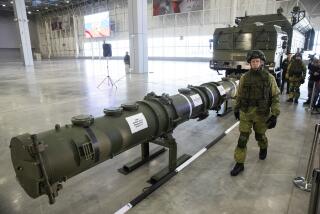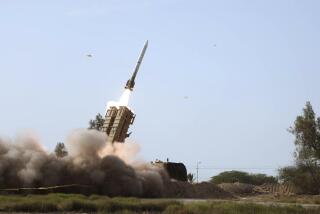Reagan Seeks Mid-Range Missile Ban in Europe, Asia
WASHINGTON — President Reagan has proposed that the United States and Soviet Union agree to “fast-track reductions” of intermediate-range missiles to eliminate them from both Europe and Asia by the end of the decade, the White House announced Monday.
Responding to Soviet leader Mikhail S. Gorbachev’s offer to rid Europe of the weapons in five to seven years, Reagan apparently sought to recapture the public relations momentum on arms control by urging that the timetable be speeded up and the scope broadened to include the Far East.
But at the same time, he rejected two conditions Gorbachev had attached to his Jan. 15 offer, thereby dimming prospects for an early breakthrough resulting from the new proposal.
Reagan’s public statement included no details of his offer, but Administration officials said it called for a 50% cut in 1987, another 50% cut in 1988 and elimination of all remaining missiles by the end of 1989, with “concurrent proportionate cuts in Asia.”
Thus, in the first year, the Soviets would cut their present force of 441 SS-20 missiles to 140 in Europe and about 85 in Asia, then halve those levels again, reducing them to zero by 1990.
It was unclear, however, whether the United States might wait under the proposal for the initial Soviet reductions before undertaking its own cuts. In the past, the United States has insisted on reductions to equal levels of warheads, not missiles--and each Soviet missile carries three warheads to one for each American weapon. Because a total of 236 Pershing 2 and cruise missiles are deployed in Europe and none are in Asia, the Soviets enjoy an advantage in warheads of 1,323 to 236.
Administration officials said that Reagan’s plan also contains stiff verification requirements to monitor any reductions, including destruction of removed missiles and on-site inspection of production facilities as well as launching sites.
Perhaps as a “sweetener,” one official said, the President’s proposal hinted that the United States might be willing to replace its Pershing 2s with shorter-range Pershing 1-B missiles, which could not reach the Soviet Union. The Pershing 2 has a range of about 1,200 miles, while the Pershing 1-B has a limit of about 500 miles.
Proposal Reaffirmed
In a letter to Gorbachev and in details presented at the U.S.-Soviet arms control talks in Geneva on Monday, Reagan reaffirmed U.S. proposals for a 50% decrease in long-range nuclear offensive forces. But in this area and that of space defense weapons, which the Soviets want totally banned, he made no new proposals beyond the offers he had made before last November’s summit with Gorbachev.
The Soviet leader had called for total elimination of all nuclear weapons in three stages by the year 2000, but Reagan said in a statement that many of the details in the Soviet plan “are clearly not appropriate for consideration at this time.”
“In our view, the total elimination of nuclear weapons will require, at the same time, the correction of the conventional and other force imbalances, full compliance with existing and future treaty obligations . . . and a demonstrated commitment by the Soviet Union to peaceful competition,” he said.
Reagan rejected Gorbachev’s call for a freeze on British and French intermediate-range missiles, as well as a U.S. pledge not to transfer such weapons to any ally.
He is understood to have replied that the United States cannot negotiate about the weapons held by Britain and France. In addition, the United States already has pledged to help Britain modernize its submarine-launched, intermediate-range missile force and would have to renege on that deal to comply with the Soviet demand.
Mid-Range Arms Stressed
The immediate focus should remain on the prompt pursuit of first steps in curbing both intermediate- and long-range offensive arms, Reagan said. But both sides appear to be concentrating on limiting the intermediate-range missiles, which hold out most hope for an early agreement, perhaps even before the next Reagan-Gorbachev summit later this year.
Two weeks ago, the Administration tentatively had decided to respond to Gorbachev by proposing the elimination of European intermediate-range missiles and a 50% cut in Soviet missiles in Asia. However, U.S. allies on both continents raised various objections to that approach during visits by American arms experts.
As a result, three new options were devised that both repackaged and changed marginally the tentative plan. Rather than accepting one, however, the White House aides “took a little from each one and massaged it their own way” to produce the new offer, one U.S. official complained, “leaving lots of noses out of joint.”
More to Read
Sign up for Essential California
The most important California stories and recommendations in your inbox every morning.
You may occasionally receive promotional content from the Los Angeles Times.










